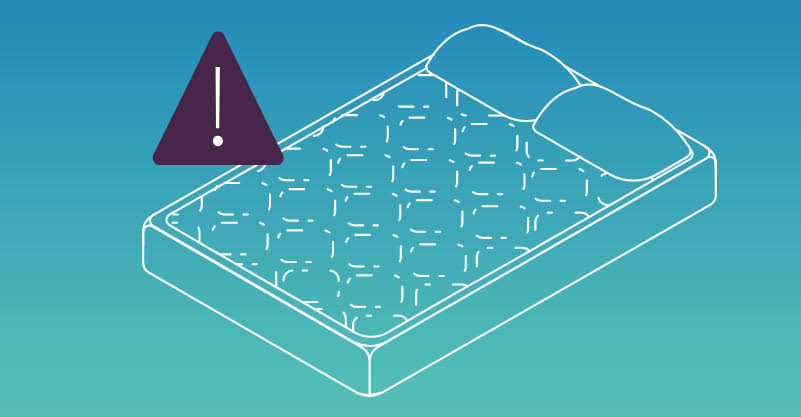
I took some time this week to read parts of the new EWG Home Guides , and found some errors that I feel warrant correction.
I’ve been monitoring Environmental Working Group for some years now and consistently feel that I can’t just stop my work and refer everyone to EWG for product recommendations. While I admire their work researching toxic chemicals and their health effects, I often do not agree with them about their safe alternative recommendations.
Alerting the public about toxic expsures and finding safe alternatives are two very different fields, which require different sets of background understanding and different collections of data.
Here’s just an example of what goes wrong when EWG starts making recommendations regarding how to choose nontoxic products.
In their new Healthy Home Guides, there’s a page on Healthist Mattresses.
Here are some misleading and outright wrong recommendations I’d like to correct on this page.
Recommendation to Look for “Natural Latex”
The term natural latex is meaningless and unregulated. Latex foam can be made from natural tree sap or petrochemicals. While one might assume that latex labeled “natural” is made from tree sap, it can also contain petrochemical latex and may contain pesticides as well.
Better to look for GOLS certified organic latex, which is made from certified organic tree sap. It’s widely available as an option for many mattresses.
Also EWG recommends latex for crib mattresses. Virtually all all latex/allergy groups (medical or otherwise) do not recommend latex for baby products because it is a well-known allergen.
Recommendation to Not Use Flame Retardants
EWG says not to use flame retardants, but then recommends Oeko-Tex and GREENGUARD Gold certification, neither of which prohibit flame retardants. Both of these two certifications permit the use of polyurethane foam filled mattresses, and, when polyurethane foam is used in a mattress, it is impossible to pass government flammability standards without flame retardants, whether those flame retardants are added into the foam or in a flame barrier that surrounds the foam. (The only exception to the use of flame retardants could be to surround the foam with wool, but I’m not aware of any brand that uses wool with polyurethane foam.)
As well, it is quite common for mattress manufacturers to downplay the use of flame retardant chemicals by making claims like “No flame retardant chemical, we only use flame barriers”. But then they don’t tell you what’s in the flame barriers. The flame barriers typically are made with various flame retardant chemicals.
Recommendation of GREENGUARD GOLD certification
The worst mistake on the page, in my opinion, is the recommendation of mattresses certified by GREENGUARD Gold, particularly crib mattresses. This certification is now meaningless in my eyes because so many of the crib mattresses are waterproofed with a layer of toxic PVC that emits dangerous phthalates.
The reason these toxic crib mattresses can be certified by GREENGUARD GOLD is because GREENGUARD does not test for phthalates. I have a letter from them confirming this. So while GREENGUARD can say these mattresses meet their standards, their standards don’t contain certain chemicals for which testing needs to be done. If all you look at is testing for a limited list of chemicals, you miss the fact that a material contains other toxic chemicals that are not on the test list. I know this because I studied PVC and I know the chemicals it outgassed. And I got the list of chemicals GREENGUARD test for and phthalates isn’t on the list. Then I verified the missing phthalates with GREENGUARD. EWG should know this about GREENGUARD. Apparently they don’t. A mattress manufacturer can actually be using absolutely prohibited phthalates and still be GREENGUARD Gold certified!
Waterproofing chemicals are not mentioned at all
In 2017 I took a look at all the major brands of crib mattressses to see what type of chemicals were used for waterproofing. I found PVC (that emit phthalates), per fluorinated chemicals (PFCs), and nanoparticles. EWG warns against exposure to all of these, but did not mention their possible presence on crib mattresses at all.
EWG Recommendations are Close, but Not Close Enough for Me
I know from experience that people who are interested in toxics want to know about ALL the toxic exposures for a particular type of product, so they can make an informed choice.
If EWG wants to set product standards and make product recommendations, they need to do a better job of it.
What we really need are some standards for nontoxic products that we can all agree on, and encourage manufacturers to meet those standards. That’s the direction I am planning to go.




Hello, so what crib mattress do you recommend then? It seems that all of the Naturepedic ones are “waterproofed” and the other ones I’ve looked at contain latex along with Coconut coir. I’m at a loss for what is safest to use?
Naturepedic DOES have two GOTS-certified organic mattresses without waterproofing, if that’s what you prefer.
1. Quilted Deluxe 252 (MC50) – this is totally non-waterproof, and just quilted organic cotton all the way around. Can also be ordered with organic wool.
2. 2 in 1 Ultra Quilted 252 – this model is waterproof on one side and quilted (no waterproofing) on the other side. Many people like the option of being able to go either way.
In a better world, manufacturers would want their products to be safe for consumers, and the earth.
Totally agree.
Thank you for not stopping your good work! Wow, we put so much trust in a place like EWG. It’s disappointing that the info is not more accurate. Thank you for pointing out the inaccuracies.